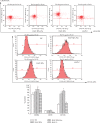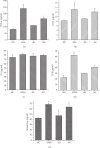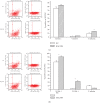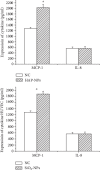Mechanistic Understanding of Cell Recognition and Immune Reaction via CR1/CR3 by HAP- and SiO2-NPs
- PMID: 32382571
- PMCID: PMC7195653
- DOI: 10.1155/2020/7474807
Mechanistic Understanding of Cell Recognition and Immune Reaction via CR1/CR3 by HAP- and SiO2-NPs
Abstract
Nanodrug carrier will eventually enter the blood when intravenously injected or in other ways. Meanwhile, a series of toxic effects were caused to the body with the formation of nanoparticle protein corona. In our studies, we try to reveal the recognition mechanism of nanoparticle protein corona by monocyte and the damage effect on immune cells by activated complement of hydroxyapatite nanoparticles (HAP-NPs) and silicon dioxide nanoparticles (SiO2-NPs). So expressions of TLR4/CR1/CR were analyzed by flow cytometry (FCM) in order to illuminate the recognition mechanism of nanoparticle protein corona by monocyte. And the expression of ROS, cytokines, adhesion molecules, and arachidonic acid was measured when THP-1 and HUVECs were stimulated by NP-activated complement. The results showed that HAP-NPs can be recognized by the opsonin receptor (iC3b/CR3) model, while plasma protein, opsonin receptor, and Toll-like receptors are all likely launch cell recognition of SiO2-NPs. And it was considerate that NP-activated complement can damage THP-1 and HUVECs, including oxidative stress, inflammation, and increased vascular permeability. So the surface of nanodrug carrier can be modified to avoid being clear and reduce the efficacy according to the three receptors (TLR4/CR1/CR3).
Copyright © 2020 Tingting Ding and Jiao Sun.
Conflict of interest statement
The authors declare that they have no conflict of interest.
Figures










Similar articles
-
Formation of Protein Corona on Nanoparticle Affects Different Complement Activation Pathways Mediated by C1q.Pharm Res. 2019 Dec 23;37(1):10. doi: 10.1007/s11095-019-2747-8. Pharm Res. 2019. PMID: 31872347
-
CR1 (CD35) and CR3 (CD11b/CD18) mediate infection of human monocytes and monocytic cell lines with complement-opsonized HIV independently of CD4.Clin Exp Immunol. 1993 Apr;92(1):106-13. doi: 10.1111/j.1365-2249.1993.tb05955.x. Clin Exp Immunol. 1993. PMID: 7682158 Free PMC article.
-
Adherence of human monocytes to haemodialysis membranes: LFA 1 (CD11a/CD18) CR1 (CD35) and CR3 (CD11b/CD18) triggering promotes the biosynthesis of platelet-activating factor and adherence.Nephrol Dial Transplant. 1995;10(9):1679-88. Nephrol Dial Transplant. 1995. PMID: 8559489
-
Effect of the protein corona on nanoparticles for modulating cytotoxicity and immunotoxicity.Int J Nanomedicine. 2014 Dec 18;10:97-113. doi: 10.2147/IJN.S72998. eCollection 2015. Int J Nanomedicine. 2014. PMID: 25565807 Free PMC article. Review.
-
Opsonins and Dysopsonins of Nanoparticles: Facts, Concepts, and Methodological Guidelines.Front Immunol. 2020 Oct 12;11:567365. doi: 10.3389/fimmu.2020.567365. eCollection 2020. Front Immunol. 2020. PMID: 33154748 Free PMC article. Review.
Cited by
-
Counteracting Immunosenescence-Which Therapeutic Strategies Are Promising?Biomolecules. 2023 Jul 6;13(7):1085. doi: 10.3390/biom13071085. Biomolecules. 2023. PMID: 37509121 Free PMC article. Review.
-
Preparation of a miR-155-activating nucleic acid nanoflower to study the molecular mechanism of miR-155 in inflammation.Mol Med. 2022 Jun 17;28(1):66. doi: 10.1186/s10020-022-00495-4. Mol Med. 2022. PMID: 35715753 Free PMC article.
-
Polymeric Carriers for Delivery of RNA Cancer Therapeutics.Noncoding RNA. 2022 Aug 2;8(4):58. doi: 10.3390/ncrna8040058. Noncoding RNA. 2022. PMID: 36005826 Free PMC article. Review.
-
Noninvasive Detection of Macrophages in Atherosclerotic Lesions Using a Visipaque-Based Nanoparticle Contrast Agent for Computed Tomography.ACS Omega. 2025 Mar 17;10(11):10979-10986. doi: 10.1021/acsomega.4c09170. eCollection 2025 Mar 25. ACS Omega. 2025. PMID: 40160795 Free PMC article.
-
Regulating the proinflammatory response to composite biomaterials by targeting immunometabolism.Bioact Mater. 2024 Jun 7;40:64-73. doi: 10.1016/j.bioactmat.2024.05.046. eCollection 2024 Oct. Bioact Mater. 2024. PMID: 38948254 Free PMC article.
References
MeSH terms
Substances
LinkOut - more resources
Full Text Sources
Miscellaneous

